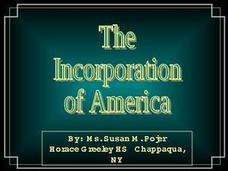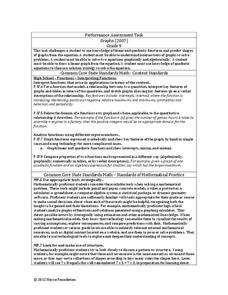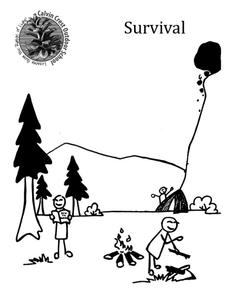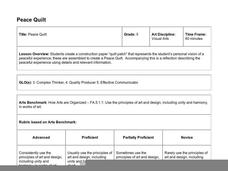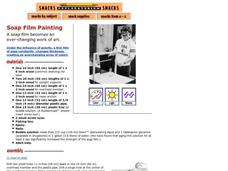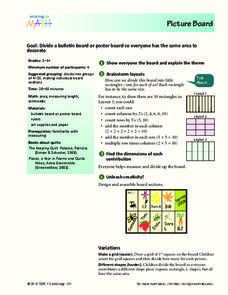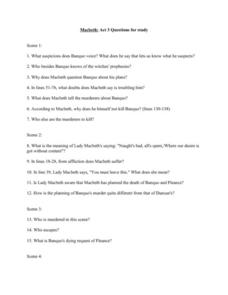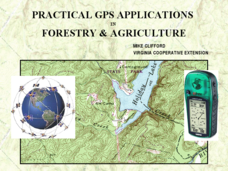Curated OER
Rate Determining Step and Catalyst Activity
Students work in groups to stuff as many envelopes as they can in 3-5 minutes. They use an assembly line method. Envelope stuffing is compared to a chemical reactions. The idea of catalyst is considered, and students determine a way to...
Curated OER
The Incorporation of America
The incorporation and industrialization of America is covered in this image-rich slide show. While text is limited, there is no shortage of great images showing the progression and causes of American Industrialization. Perfect...
Curated OER
Understanding Stage Design: Using Visual Elements to Provide Information to an Audience
Young scholars study about theatrical design by developing environments for improvised and scripted scenes. They develop focused ideas for an environment using visual elements.
Curated OER
Contour Hand Gestures with Text
Students examine different types of hand drawings. They create their own 3-D contour drawings. They also discuss the use of symbolism in art.
Science Matters
Fault Formations
The San Andreas Fault moves about two inches a year, approximately the same rate fingernails grow—crazy! The third lesson in the series allows for hands-on exploration of various fault formations. Through the use of a Popsicle stick,...
Curated OER
Analyzing Folklore: Redwall
Brian Jacques’ novel Redwall provides the focus for a series of lessons involving the analysis of folklore. Adopting the persona of a character, groups write letters in the voice of their character, assemble a collage using Microsoft...
Curated OER
Introduce Michigan
Fourth graders explore Michigan. In this geography skills instructional activity, 4th graders read textbook pages about the state and then participate in a classroom activity that requires them to be part of an assembly line.
Curated OER
Producing and Consuming
Second graders make a booklet. In this economics lesson, 2nd graders define producers and consumers. They make an assembly line accordion booklet to demonstrate how producers and consumers work together to make and use goods.
Inside Mathematics
Graphs (2007)
Challenge the class to utilize their knowledge of linear and quadratic functions to determine the intersection of the parent quadratic graph and linear proportional graphs. Using the pattern for the solutions, individuals develop a...
Curated OER
Ford's Revolution (Differentiated by Ability)
Students explore the effects of Ford's use of the assembly line, auto financing, and increased wages to make his fortune. They complete a worksheet using the internet.
Curated OER
Community Helpers
First graders explore the different products and services provided by community helpers. In this community helpers lesson, learners participate in a role playing activity where the students transform into community helpers. They break...
Lunar and Planetary Institute
Moon Flip Book
Watch an entire month flash before your eyes with this fun phases-of-the-moon flip book activity.
Calvin Crest Outdoor School
Survival
Equip young campers with important survival knowledge with a set of engaging lessons. Teammates work together to complete three outdoor activities, which include building a shelter, starting a campfire, and finding directions in the...
Curated OER
Lao Design: Mask making
Students examine the concept of symmetry in Lao art and apply it to their own works. They construct full-face masks by copying the stencils onto colored paper. Students apply creative touches by painting and drawing on their assembled...
Hawaiʻi State Department of Education
Peace Quilt
Learners explore color, shape, line, balance, radial symmetry, unity, repetition, and pattern as they make a peace quilt inspired by those made by Hawaiian women in the 1800s. After learning a bit about the history or peace quilts, the...
Exploratorium
Soap Film Painting
If you are up for constructing a wooden frame, you can do this demonstration of the interference patterns when light reflects off of layers of soapy film. Both constructive and destructive interference can be seen as evidenced by the...
PBS
Four Corners
It's imperative to be as precise as possible. Future engineers learn about precision by building a cardboard machine. The base, corners, handles, and paddles must all be assembled with precision or the machine won't work.
Curated OER
Picture Board
Learners divide a poster board so everyone gets the same amount of area to decorate. Youngsters talk about the different ways to divide a rectangle. They measure their lines to make sure that each piece is equal and then decorate their...
Curated OER
Goldsworthy Project: Building With the Five Elements of Art
Seventh graders explore the five elements of art: line, shape, value, texture and color. They collect items from nature and arrange them aesthetically taking the five elements into consideration. They consider their work from several...
Lesson Locker
Macbeth: Act Three Questions for Study
The 29 specified questions included in this resource cover the climax in Act three of Shakespeare’s Macbeth. Test your students by using this activity as a reading check quiz, group work exercise, or to illicit class discussion. If...
Curated OER
Benham's Disk
Seeing is believing! Or is it? With this simple experiment, young scientists can explore the concept of visual perception. Attach Benham's disk to a rotating appliance such as a hand drill; As it spins, the black lines appear to be...
Curated OER
Practical GPS Applications in Forestry & Agriculture
An explanation of the Global Positioning System (GPS) and the Geographic Information System (GIS) is given in this presentation. Uses and applications are considered. How it works and sources of error are also touched upon. A large...
Curated OER
Welcome to My Community!
A "Welcome to Our Community" brochure culminates research into the people and places of interest in your community. Class members work alone or in pairs to gather information, illustrate, and write about various topics. Materials are...
Curated OER
On the Road
Students investigate the history of the automobile in the United States. They complete a Webquest, explore the PBS website, answer discussion questions, and locate and discuss newspaper articles about cars and travel.



